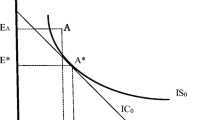Abstract
This article illustrates the use of bounded rationality concepts in policy analysis. Specifically, we discuss reasons why we expect residential energy consumption to deviate from the utility-maximizing level when multiple-tier rate structures are in use. Then we construct a simple, predictive model of boundedly-rational household behavior which can be tested against a conventional utility-maximization model. Our model predicts that households will over-consume when facing increasing tier rates and under-consume when facing decreasing tier rates.
We then discuss some of the policy consequences of this behavior. One consequence, given the kind of increasing tier structures that are common in the United States, is that the magnitude of the overconsumption for a household is plausibly 10 percent in the short-run and 50 percent in the long-run. Another consequence, if policy is constrained to increasing tier rates with constant total consumer subsidy, is that the most efficient of these is likely to have a lower first-tier price and quantity than would be the case without bounded rationality. Finally, we note that both the bounded-rationality model and the utility-maximizing model support the use of a two-part tariff rate structure over tiered rate structures for residential consumers.
Zusammenfassung
Der vorliegende Beitrag wendet das Konzept eingeschränkter Rationalität auf energiepolitische Zusammenhänge an. Es wird insbesondere erörtert, wie sich der Energieverbrauch privater Haushalte unter der Annahme eingeschränkter Rationalität von dem unterscheidet, wie er sich bei vollständiger Rationalität (Nutzenmaximierung) ergeben würde — vorausgesetzt, es gilt ein mehrfach gestaffelter Tarif. Die Autoren stellen ein einfaches Vorhersagemodell beschränkt rationalen Haushaltsverhaltens vor, das gegen ein konventionelles Nutzen-Maximierungsmodell getestet werden kann. Nach diesem Modell werden Haushalte bei progressiv gestaffelten Tarifen zu Überkonsum und bei degressiv gestaffelten Tarifen zu Unterkonsum tendieren.
Anschließend werden einige politische Konsequenzen dieses Verhaltens diskutiert. Bei der Form progressiv gestaffelter Tarife, die in den USA üblich ist, ist eine Konsequenz, daß die Größenordnung des Mehrverbrauchs eines Haushaltes bei kurzfristiger Betrachtung bei 10%, bei längerfristiger Betrachtung bei 50% liegt. Wenn sich die Tarifpolitik auf progressiv gestaffelte Stufentarife mit konstanter Gesamtversorgung beschränkt, ist eine andere Konsequenz, daß die wirkungsvollste Tarifgestaltung bei beschränkter Rationalität einen niedrigeren Eingangstarif und eine niedrige Eingangsmenge fordert. Schließlich wird ausgeführt, daß sowohl das Modell eingeschränkter Rationalität wie auch das Nutzen-Maximierungs-Modell für einen zweistufigen Tarif anstelle eines mehrfach gestaffelten Tarifs spricht.
Similar content being viewed by others
References
Akerlof, G., & Yellen, J. (1985). Can small deviations from rationality make significant differences to economic equilibria? American Economic Review, 75, 708–720.
Colantoni, C. S., Davis, O. A., & Swaminuthan, M. (1976). Imperfect consumers and welfare comparisons of policies concerning information and regulation. Bell Journal of Economics, 7, 602–615.
Frieden, B., & Baker, K. (1983). The market needs help: The disappointing record of home energy conservation. Journal of Policy Analysis and Management, 2, 432–448.
Friedman, L. (1984). Microeconomic policy analysis. New York: McGraw-Hill.
Friedman, L. (1987). Energy utility pricing: The recent record in California. Berkeley, CA: University of California, Graduate School of Public Policy. Working Paper No. 125.
Grether, D., & Plott, C. (1979). Economic theory of choice and the preference reversal phenomenon. American Economic Review, 69, 623–628.
Kahneman, D., & Tversky, A. (1973). On the psychology of prediction. Psychological Review, 80, 237–251.
Kahneman, D., & Tversky, A. (1979). Prospect theory: An analysis of decision under risk. Econometrica, 47, 263–291.
Kahneman, D., & Tversky, A. (1981). The framing of decisions and the psychology of choice. Science, 211, 453–458.
Kempton, W., & Montgomery, L. (1982). Folk qualification of energy. Energy, 7, 817–827.
Kunreuther, H. (1976). Limited knowledge and insurance protection. Public Policy, 24, 227–261.
Lindman, H. (1971). Inconsistent preferences among gambles. Journal of Experimental Psychology, 89, 390–397.
Russell, T., & Thaler, R. (1985). The relevance of quasi rationality in competitive markets. American Economic Review, 75, 1071–1082.
Simon, H. (1959). Theories of decision-making in economics and behavioral science. American Economic Review, 49, 223–283.
Simon, H. (1979). Rational decision making in business organizations. American Economic Review, 69, 493–513.
Slovic, P. (1975). Choice between equally valued alternatives. Journal of Experimental Psychology: Human Perception and Performance, 1, 280–287.
Slovic, P., & Lichtenstein, S. (1983). Preference reversals. American Economic Review, 73, 596–605.
Stern, P. (1986). Blind spots in policy analysis: What economics doesn't say about energy use. Journal of Policy Analysis and Management, 5, 200–227.
Thaler, R. (1980). Toward a positive theory of consumer choice. Journal of Economic Behavior and Organization, 1, 39–60.
Additional information
Lee S. Friedman is Professor of Public Policy in the Graduate School of Public Policy, University of California at Berkeley, Berkeley, CA 94720, USA. Karl Hausker is a staff Economist at the U.S. Senate Energy and Natural Resources Committee, Dirksen Senate Office Building, Room 358, Washington, D.C. 20510, USA.
The authors are grateful to the University of California Energy Research Group for its support of this research. They would like to thank Suzanne Scotchmer, the Editors, and two anonymous referees for their helpful comments.
Rights and permissions
About this article
Cite this article
Friedman, L.S., Hausker, K. Residential energy consumption: Models of consumer behavior and their implications for rate design. J Consum Policy 11, 287–313 (1988). https://doi.org/10.1007/BF00411952
Issue Date:
DOI: https://doi.org/10.1007/BF00411952




